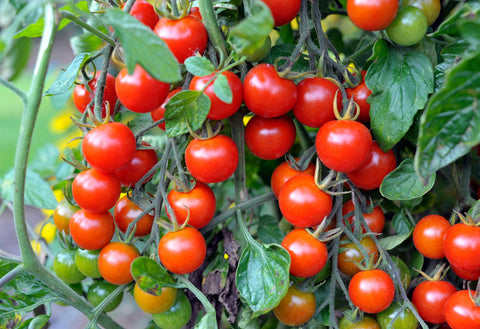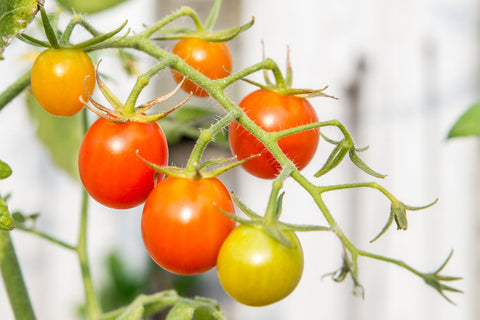Tomatoes are a staple in many gardens, adding vibrant colors and flavors to salads, sauces, and sandwiches. Whether you're a seasoned gardener or just starting out, mastering the art of growing tomatoes can be immensely rewarding. In this comprehensive guide, we'll explore essential tips and techniques to help you cultivate healthier plants and enjoy a bountiful harvest from seed to harvest.

Selecting the Right Tomato Varieties
Understanding determinate and indeterminate varieties
Tomatoes come in two main types: determinate and indeterminate. Determinate varieties typically grow to a fixed height and produce fruit all at once, making them ideal for compact spaces or container gardening. On the other hand, indeterminate varieties continue to grow and produce fruit throughout the season, requiring sturdy support structures and ample space to thrive.
Consideration of climate and growing conditions
Tomatoes thrive in warm, sunny climates, but they can be grown successfully in a variety of conditions. Before selecting tomato varieties for your garden, consider factors such as temperature, sunlight exposure, and soil quality to ensure optimal growth and productivity.
Disease-resistant varieties for healthier plants
Tomatoes are susceptible to a range of diseases, including blight, wilt, and mosaic virus. Choosing disease-resistant varieties can help minimize the risk of these common ailments, reducing the need for chemical treatments and promoting overall plant health.
Starting from Seeds
Importance of high-quality seeds
Starting tomatoes from seeds allows you to select unique varieties and ensure the health and vigor of your plants from the very beginning. Choose reputable seed suppliers and opt for heirloom or open-pollinated varieties for the best results.
Germination techniques for successful seedlings
To ensure successful germination, provide the right combination of warmth, moisture, and light for your tomato seeds. Consider using a seedling heat mat to maintain consistent temperatures and covering trays with plastic domes to retain moisture during the germination process.
Seedling care for strong, healthy plants
Once your tomato seeds have germinated, proper care is essential to promote healthy growth and development. Provide adequate light, water, and nutrients, and gradually acclimate seedlings to outdoor conditions before transplanting them into the garden.
Preparing the Soil
Soil testing and analysis
Healthy soil is the foundation of a successful tomato garden, so it's essential to test your soil and make any necessary amendments before planting. Conduct a soil test to determine pH levels and nutrient content, and amend the soil as needed to optimize growing conditions for your tomato plants.
Soil amendments for optimal nutrient levels
Incorporate organic matter such as compost, aged manure, or worm castings into your soil to improve structure and fertility. Consider adding specific nutrients like phosphorus and potassium to promote healthy root development and fruit production.
Mulching techniques for moisture retention
Applying mulch around tomato plants helps conserve moisture, suppress weeds, and regulate soil temperature. Choose organic mulches like straw, shredded leaves, or grass clippings, and apply a layer several inches thick around the base of plants, taking care not to smother stems or foliage.

Planting Tomatoes
Timing considerations for planting
Wait until after the danger of frost has passed and soil temperatures have warmed to at least 60°F (15°C) before planting tomatoes outdoors. Consult local gardening resources or extension offices for specific recommendations based on your location.
Proper spacing for adequate growth
Give your tomato plants plenty of room to spread out and access sunlight by spacing them at least 18 to 24 inches apart in rows, with 36 to 48 inches between rows. This allows for adequate airflow and reduces the risk of disease.
Transplanting techniques for seedlings
When transplanting tomato seedlings into the garden, dig a hole deep enough to accommodate the root ball and remove any lower leaves that would be buried beneath the soil. Plant seedlings slightly deeper than they were growing in their containers to encourage strong root development.
Providing Proper Support
Choosing between staking and caging methods
Tomato plants require support to prevent sprawling growth and protect delicate stems and fruit. Choose between staking, caging, or trellising methods based on your garden layout and personal preferences.
Benefits of trellising for vertical growth
Trellising tomato plants allows them to grow vertically, maximizing space and sunlight exposure while reducing the risk of disease and pest damage. Use sturdy trellises or supports to prevent bending or breakage as plants mature and produce heavy fruit.
Techniques for tying up vines as they grow
As tomato plants grow, they may require additional support to keep them upright and stable. Use soft ties or strips of fabric to gently secure vines to stakes or trellises, avoiding damage to stems and foliage.
Watering and Fertilizing
Importance of consistent watering schedules
Tomatoes require consistent moisture throughout the growing season to prevent issues like blossom end rot and cracking. Water deeply and evenly, aiming to keep the soil consistently moist but not waterlogged.
Types of fertilizers suitable for tomatoes
Provide essential nutrients to tomato plants by incorporating balanced fertilizers into your soil or using organic amendments like compost, fish emulsion, or bone meal. Avoid over-fertilizing, as excessive nitrogen can lead to lush foliage but reduced fruit production.
Avoiding over-fertilization to prevent nutrient imbalances
While tomatoes require nutrients for healthy growth, it's essential to avoid over-fertilizing, which can lead to nutrient imbalances and environmental pollution. Follow recommended application rates and schedules, and monitor plants for signs of deficiency or excess.

Pruning for Healthy Growth
Removing suckers to promote fruit production
Suckers are small shoots that emerge from the leaf axils of tomato plants and can divert energy away from fruit production. Remove suckers when they are small and tender, using clean pruning shears to make clean cuts near the main stem.
Trimming lower leaves for improved airflow
As tomato plants mature, it's common for lower leaves to turn yellow or become shaded by dense foliage. Trim away these leaves as needed to improve airflow and reduce the risk of fungal diseases like blight.
Techniques for proper pruning without damaging plants
When pruning tomato plants, aim to create an open, airy structure that allows sunlight to reach all parts of the plant. Focus on removing excess foliage and maintaining a balanced shape, taking care not to remove too much growth at once.
Managing Pests and Diseases
Common pests affecting tomato plants
Tomato hornworms, aphids, and whiteflies are just a few of the pests that can wreak havoc on tomato plants. Keep an eye out for signs of infestation, such as chewed leaves or sticky residue, and take action promptly to prevent damage.
Organic pest control methods for healthier crops
Instead of resorting to chemical pesticides, consider using organic pest control methods like companion planting, beneficial insects, and homemade remedies like neem oil or garlic spray. These natural solutions can effectively manage pests without harming beneficial insects or contaminating your food.
Identifying and treating common tomato diseases
Tomatoes are susceptible to various fungal and bacterial diseases, including early blight, late blight, and powdery mildew. Learn to recognize the symptoms of these diseases, such as yellowing leaves, dark spots, or powdery growth, and take appropriate measures to prevent their spread.
Monitoring and Maintenance
Regular inspections for signs of stress or disease
Set aside time each week to inspect your tomato plants for signs of stress, disease, or pest damage. Look for yellowing or curling leaves, unusual spots or discoloration, and any signs of insect activity or damage.
Adjusting care routines based on plant needs
Pay attention to environmental factors like temperature, humidity, and rainfall, as well as the growth stage of your tomato plants. Adjust watering, fertilizing, and pruning practices as needed to address changing conditions and promote healthy growth.
Prompt intervention to address issues before they escalate
If you notice any problems with your tomato plants, take immediate action to address them before they worsen. Whether it's removing diseased foliage, applying organic remedies, or adjusting your care routine, proactive intervention can help minimize damage and maximize yields.

Ripening and Harvesting
Signs of ripe tomatoes ready for harvest
Ripe tomatoes should be firm yet slightly soft to the touch, with vibrant coloration and a fragrant aroma. Look for uniform ripening across the entire fruit and avoid harvesting tomatoes that are still green or overly ripe.
Proper harvesting techniques to avoid damage
To harvest tomatoes, gently twist or snip them from the vine using clean pruning shears, leaving a small stem attached. Handle tomatoes with care to avoid bruising or damaging the delicate skin, and place them in a single layer to prevent crushing during transport.
Ripening tomatoes off the vine for optimal flavor
If you have tomatoes that are still slightly green when the growing season ends, you can ripen them indoors by placing them in a warm, sunny location or storing them in a paper bag with a ripe banana or apple. Check tomatoes regularly for ripeness and use them promptly once fully matured.
Storing and Preserving Your Harvest
Best practices for storing fresh tomatoes
Store freshly harvested tomatoes at room temperature away from direct sunlight, checking them regularly for ripeness and using them before they become overripe. Avoid refrigerating tomatoes, as this can negatively impact their flavor and texture.
Creative ways to preserve excess harvest
If you find yourself with an abundance of tomatoes, consider preserving them by canning, freezing, or drying them for later use. Alternatively, experiment with different recipes such as salsas, sauces, soups, or salads to make the most of your harvest.
Sharing the bounty with friends and family
Don't forget to share the bounty of your tomato harvest with friends, family, and neighbors. Whether you give away surplus produce or host a tomato-themed gathering, sharing the fruits of your labor is a rewarding way to spread joy and community spirit.
Troubleshooting Common Problems
Yellowing leaves and nutrient deficiencies
Yellowing leaves can indicate nutrient deficiencies or environmental stressors like overwatering or poor soil drainage. Address these issues promptly by adjusting watering and fertilizing practices and providing proper care for your plants.
Blossom end rot and other fruit disorders
Blossom end rot is a common issue affecting tomatoes, caused by calcium deficiency or irregular watering. To prevent this problem, maintain consistent moisture levels and incorporate calcium-rich amendments into your soil.
Environmental stressors impacting plant health
Environmental stressors like extreme temperatures, drought, or excessive rainfall can impact the health and productivity of tomato plants. Take steps to protect your plants from these factors, such as providing shade during heatwaves or covering them during heavy rains.

Maximizing Yields with Companion Planting
Benefits of companion planting for tomatoes
Companion planting offers numerous benefits for tomato growers, including improved pollination, pest control, and soil health. By strategically interplanting tomatoes with compatible species, you can create a more diverse and resilient garden ecosystem.
Compatible plants to enhance tomato growth
Choose companion plants that complement tomatoes by attracting beneficial insects, repelling pests, or providing shade and support. Popular companion plants for tomatoes include basil, marigolds, and nasturtiums.
Strategies for incorporating companion plants into your garden
Integrate companion plants into your garden beds or container plantings by interplanting them with tomatoes or placing them strategically around the perimeter of your garden. Experiment with different combinations to find what works best for your specific growing conditions.
Conclusion
Growing better tomatoes is a rewarding endeavor that requires patience, attention to detail, and a willingness to learn from both successes and failures. By implementing the essential tips and techniques outlined in this guide, you'll be well on your way to cultivating healthier plants and enjoying a bountiful harvest of delicious, homegrown tomatoes. So roll up your sleeves, dig in the dirt, and get ready to savor the fruits of your labor!













